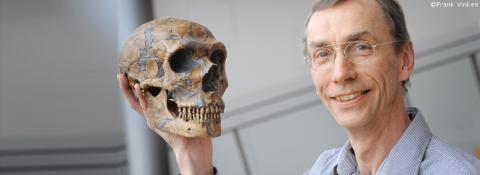Reactions to Nobel Prize in Chemistry for Bertozzi, Meldal and Sharpless for click chemistry and its use in living organisms
The Nobel Prize in Chemistry 2022 has been awarded to Barry Sharpless and Morten Meldal for laying the foundations of click chemistry, which quickly and efficiently joins molecular building blocks; and to Carolyn Bertozzi, who pioneered bioorthogonal reactions, which use this technique inside living organisms without altering the chemistry of the cell.
From left to right, Carolyn R. Bertozzi, Morten Meldal, and K. Barry Sharpless. / Nobel Prize Outreach.
Héctor Busto - Nobel Química EN
Héctor Busto Sancirián
University professor, chemistry department
So-called 'click chemistry' has been in numerous Nobel Prize bids in recent years. In the early 2000s, Barry Sharpless - by the way, winner of another Nobel for asymmetric epoxidation reactions - introduced the seemingly simple concept of making reactions fast, with few reactants, with few by-products and, if possible, in an aqueous solvent. Basic science, which, as is so often the case, laid the foundations for so-called bioorthogonal chemistry, when Carloyn Bertozzi used the methodology developed by Sharpless to perform chemical reactions in living organisms, with enormous potential for the development of new drugs.
The rest is the history of chemistry and science.
Raluca Fratila - Nobel Química EN
Raluca M. Fratila
Ramón y Cajal researcher at the University of Zaragoza working in the field of bioorthogonal chemistry
The term 'click chemistry', coined in 2001 by K. Barry Sharpless and Morten Meldal, includes a series of chemical reactions that possess unique characteristics in terms of selectivity, fast kinetics, simplicity, high yields, absence of side products and robustness. Click chemistry has brought enormous advances in chemistry, nanotechnology and materials science.
When, in addition to all the above characteristics, the compatibility of these reactions with the biological conditions of living cells and organisms is added as a requirement, the impact of Carolyn Bertozzi's development of bioorthogonal chemistry is evident. Bioorthogonal chemistry has represented a true revolution for biology, biochemistry and nanobiotechnology, providing unprecedented tools for the visualisation and analysis of biomolecules in their biological environment and giving rise to new diagnostic and therapeutic applications.
It is, of course, a well-deserved recognition of the incredible impact of click chemistry and bioorthogonal chemistry in different areas of science. As a researcher working in the field of bioorthogonal chemistry applied to nanotechnology, I warmly welcome this fantastic achievement - my sincere congratulations to all three award winners!
Fernando Herranz - Nobel Química EN
Fernando Herranz
Group Leader in Nanomedicine and Molecular Imaging, Institute of Medicinal Chemistry (IQM) of CSIC
The Nobel Prize in Chemistry 2022 rewards the development of one of the most useful chemistries developed in recent decades. Click chemistry makes it possible to carry out reactions with unprecedented selectivity, to get only what you want to react.
Bioorthogonal chemistry, mainly with Carolyn Bertozzi, goes one step further and allows this selectivity to be achieved, but under biological conditions, in a living being. This type of chemistry is having an impact in fields as varied as diagnostic imaging, cancer treatment and the development of new materials.
Milagros Piñol - Nobel Química EN
Milagros Piñol
Researcher at the Department of Organic Chemistry, Faculty of Science-Institute of Nanoscience and Materials of Aragon (INMA), University of Zaragoza-CSIC
This was a fantastic recognition. The term 'click chemistry' already demonstrates the ingenuity of K.Barry Sharpless and Morten Meldal in identifying a set of chemical reactions that are particularly useful for their simplicity and effectiveness in building complex molecules from simpler and therefore more easily accessible ones.
Click chemistry' is such a powerful chemical toolkit that there are examples of its use to make molecules with unusually diverse applications in materials science, nanotechnology, biology, natural products chemistry and pharmaceutical chemistry, to name but a few. That Carolyn R. Bertozzi shares this award for her ability to transfer the concept to the development of 'bioorthogonal reactions' in living organisms is the best demonstration of what can be achieved.
Carme Rovira - Nobel Química EN
Carme Rovira
ICREA research professor and leader of the QSBio research group at the University of Barcelona
It has been a wonderful news to hear about the Nobel prize in Chemistry awarded to Carolyn R. Bertozzi, Morten Meldal y K. Barry Sharpless, for the development and applications of click chemistry! Bertozzi, in particular, founded the area of “bioorthogonal chemistry”, in which simple chemical tools (specific chemical reactions) are used to modify molecules in cells without altering the “normal functioning” of the particular system or cell. She is a pioneer of using chemistry to manipulate biology, for instance using bioorthogonal tools “visualize”, image and modify biomolecules, such as glycans (sugars) on the surface of our cells. Actually the impact of her work in glycobiology has been enormous.
She is an inspiration for many of us, not only for her ground breaking discoveries (such as the link between cancer and cell glycans) but also for the way she communicates them to specialized and general public.
José Luis Mascareñas - Nobel Química EN
José Luis Mascareñas
Scientific Director of the Singular Centre for Research in Biological Chemistry and Molecular Materials (CiQUS) at the University of Santiago de Compostela
The possibility of programming molecules to react quickly and selectively ("click") with each other in the presence of many others has opened up immense possibilities for preparing and modifying functional materials or drugs, or for developing diagnostic methods, among other things. This click chemistry, discovered by Meldal and Sharpless, has been extended to living cells, and even to living organisms, thanks to Bertozzi's work, and has become one of the most useful tools for understanding and manipulating biology.
David Díaz Díaz - Nobel Química EN
David Díaz Díaz
Distinguished Researcher (Beatriz Galindo senior) and leader of the research group Advanced Functional Materials and Nanoscience (AFM-NANO) at the University of La Laguna
This award is a source of great pride for chemists in general and organic chemists in particular. A well-deserved award for the three laureates as the impact of click chemistry - and in particular the 1,3-dipolar cycloaddition of alkynes and azides as the most relevant example - has crossed the boundaries between scientific disciplines, becoming an enormously useful tool in many fields. Clearly inspired by the way nature works, the philosophy of click chemistry has helped chemists to have a fundamental tool to design and manufacture new multifunctional molecular entities.
As I have worked with and know him personally, I would also highlight the great human qualities of Professor Sharpless, his unique way of understanding chemistry and his generosity in sharing his knowledge.
Conflict of interest: has collaborated on research with Barry Sharpless.
Jesús Mª Aizpurua - Nobel Química EN
Jesús Mª Aizpurua Iparraguirre
Professor of Organic Chemistry at the University of the Basque Country (UPV/EHU)
With the discovery at the turn of the century of a catalytic methodology for coupling azides and alkynes under mild conditions, simple to execute and easy to scale up, Morten Meldal and Barry Sharpless laid the foundations of what Sharpless christened "click chemistry". It was precisely this idea of a "molecular layman", accessible to those inexperienced in synthesis, that led to an unstoppable expansion of the methodology beyond organic chemistry, contributing to the advancement of areas of knowledge such as medicinal chemistry, biochemistry, materials science, nanotechnology, etc. Moreover, following the pioneering contribution of Meldal and Sharpless, the concept of "click chemistry" has been extended to more than a dozen organic reactions that continue to enrich the arsenal of useful and practical molecular tools for the scientific community.
Carolyn Bertozzi elegantly extrapolated the simplicity of click chemistry to the complexity of biological media. Using tensile alkynes and eliminating the metal catalysts needed for the Meldal and Sharpless reactions, she carried out for the first time chemical reactions capable of covalently linking cells, fluorescent markers, monoclonal antibodies, nanoparticles or therapeutic agents. This approach has been a true revolution not only for the advancement of biomedical research, but also for the development of new drugs. This year's Nobel Prize is recognition of simple but effective chemistry.


